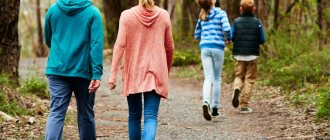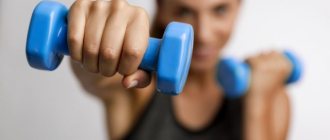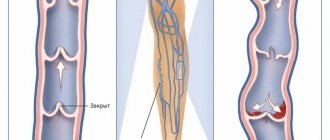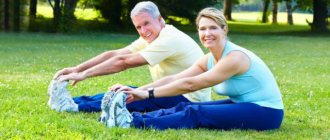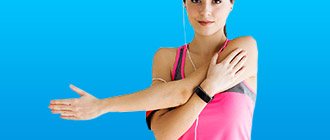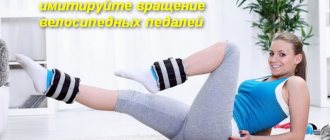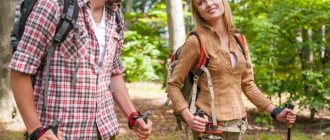Many women face the problem of varicose veins. This disease affects about 20% of the entire adult female population, three times more often than men. Varicose veins in themselves are not a disease, but only a symptom of chronic venous insufficiency. This disease can have very serious consequences, so varicose veins should not be considered only as a cosmetic problem. Varicose veins need to be treated, and it is best to try to prevent it in advance. Physical activity is of great importance for both the prevention and treatment of dilated veins. Which sports are useful for varicose veins, and which, on the contrary, can aggravate the problem.
The benefits of sports for varicose veins
If you notice signs of varicose veins on yourself, this does not mean that you should give up physical activity. Exercises to improve muscles and blood circulation in the lower extremities are very beneficial. It is advisable to perform the same exercises as during prevention, but you must remember that the exercises performed should not overexert your legs. However, you should avoid heavy or prolonged exercise, which will strain the already poor circulation in your legs. Particularly contraindicated are types of exercise such as weightlifting and intense training in the gym. But exercise in an aquatic environment, such as swimming or water aerobics, is highly recommended. If possible, you should also sleep with your legs slightly elevated, so that your limbs are higher than your body.
A condition that contributes to the development of varicose veins of the lower extremities, especially if you have a predisposition to it, is pregnancy. This is due to increased blood volume during pregnancy, as well as decreased elasticity of the veins and pressure on the veins through the enlarged uterus. Thus, moderate physical activity during pregnancy, and especially exercises for the leg muscles, is indicated during pregnancy. Walking, which is a moderate but desirable form of activity, is especially recommended by experts.
The benefits of physical activity for varicose veins include the following factors:
- Strengthening the walls of blood vessels;
- Increasing overall endurance during training;
- Maintaining soft tissue tone;
- Preventing the progression of already developed varicose veins;
- Stimulation of normal blood circulation and lymph flow, which prevents the formation of blood clots.
However, often when a woman suffers from varicose veins, physical activity alone may not be enough as a treatment. Varicose veins can be treated with ointments, oral medications, compression stockings, and sometimes require more or less extensive surgery. Varicose veins should not be underestimated! Without proper treatment, it can not only cause ulceration or inflammation, but also cause bleeding. Ignoring varicose veins can also develop into vein thrombosis, which has even more serious consequences.
You can play sports if you have varicose veins. And even necessary
80% of cases of detected varicose veins are the second stage of the disease, when not only the veins bulge out, but there are also symptoms: swelling, heaviness in the legs, legs get tired and hurt. These symptoms mainly appear when a person sits or stands in one position for a long time. When playing sports, there are usually no such sensations. On the contrary, running, squats, even strength exercises on the legs are good for the veins - they all improve venous outflow. Sports games - volleyball, football - also relieve varicose veins in the legs.
The only sports activity that worsens venous outflow is lifting weights, and more specifically, a barbell heavier than a person’s own weight. Injuries can also be dangerous (impacts to the leg can cause thrombosis) and some static postures (for example, static positions in a squat and half-squat). And everything related to movement is good for veins, even regular walking. Exercises for the mobility of the foot, leg, and calf muscles are especially useful - there are veins that are well involved in the outflow. Standing and sitting are bad for veins, but walking and lying are good.
Varicose veins are also common among athletes. But if a person is active, then he tolerates the disease more easily. Athletes with varicose veins seek help later than others because their symptoms are partially compensated by training. However, this does not mean that athletes do not need to treat existing varicose veins.
Yoga for varicose veins
The benefits of yoga for varicose veins are undeniable. The main goal of yoga is stretching and developing proper breathing. This, in turn, forms proper blood circulation and improves vascular tone. Yoga for varicose veins is indicated both as a treatment and for the prevention of this disease. Light basic exercises are also recommended for pregnant women. The correct technique for performing exercises strengthens blood vessels and improves the functioning of the cardiovascular system. In particular, the focus should be on muscle activation in gentle but dynamic exercises that engage all areas of the body (bending, back bending, side bending, bending in various positions).
Working with various muscle parts reduces blood retention in the veins and also increases the tone of the whole body, activating blood and lymph circulation in all organs. In various textbooks and yoga manuals, the exercises recommended for the prevention of varicose veins involve performing vajrasana. This is a special position in which you need to kneel with your feet on the floor, cross your big toes, lower your buttocks onto your heels and place your palms on your knees. At the same time, you must keep your back straight, but not tense. Next, you need to stay in this position from a minute to five or longer.
The price to pay for walking upright: how varicose veins work
Varicose veins are the expansion of varicose veins.
The veins in the legs are needed for the outflow of blood: blood flows through the arteries to the leg, through the veins - from the legs to the heart. My legs are always down, the blood has to flow against the force of gravity - up, it’s hard. The legs have the most unfavorable blood flow in the entire body.
“Genetically, a person is not yet fully adapted to walking upright, so there are weak points in the body,” explains Dmitry Averyanov. Every third woman and every fifth man initially has weak spots in the veins of the legs. During life, the vein in these places expands due to stress: for some from pregnancy, for others from lifting heavy objects or being overweight. There can be many reasons, but the root cause is weakness of the venous wall.
Veins have valves that facilitate the upward movement of blood. When the vein dilates, these valves stop closing and the vein cannot hold blood.
The blood partially begins to flow back down. “The leg is always like an unfinished bottle - there is always residual venous blood in it,” notes Dmitry Averyanov. This causes the unpleasant symptoms characteristic of varicose veins: heaviness in the legs, swelling, fatigue, bulging veins.
At the same time, there are a lot of veins in the legs: deep, muscular, subcutaneous, but varicose veins only affect the subcutaneous ones.
Fitness for varicose veins
Fitness is, first of all, cardio training aimed at increasing the heart rate. Fitness helps speed up metabolic processes in the body, stimulates the heart, and, as a result, increases blood circulation. This is an excellent sport for the prevention and treatment of varicose veins, however, when performing various sets of exercises, it is necessary to ensure that the legs are not subjected to excessive stress. To prevent the walls of blood vessels from being stretched even more in case of increased loads, you need to buy compression socks or stockings and wear them during training. This will protect your blood vessels from increased pressure and prevent the formation of blood clots.
Recommendations
Do not despair if varicose veins are diagnosed. A phlebologist will tell you which sport to choose. Illness is not a death sentence. The main thing is that the chosen sports for varicose veins do not overload the blood vessels, avoid heavy weights and shock loads on the legs.
In addition, you need to monitor your health by adjusting your diet and choosing the right regimen. It is necessary to exclude spicy and fatty foods from the menu, reduce the consumption of carbohydrates and animal fats. Alcohol and smoking should be completely avoided.
You cannot wear tight shoes. This will lead to poor circulation and the risk of blood clot formation.
You can reduce the load on your legs by losing excess weight. Therefore, moderate exercise for varicose veins and maintaining physical activity will be very useful.
Swimming for varicose veins
Swimming is a wonderful sport that is recommended for many diseases. Despite the fact that several hours in the pool are more like relaxation than exercise, in the aquatic environment the human body spends a lot of calories, and the muscles and skeleton of the musculoskeletal system are effectively strengthened. Water puts pressure on the walls of blood vessels, maintaining their tone. The benefits of swimming for varicose veins boil down to the following:
- Optimal load on veins and vessels;
- Excellent general strengthening of the whole body;
- Strengthening the musculoskeletal system;
- The ability to quickly burn extra calories;
- Improving the functioning of the cardiovascular system;
- Stimulation of the tone of venous valves.
Swimming will be the best sport for you if you want to get rid of varicose veins or prevent their occurrence. Also effective subtypes of this sport include water aerobics, polo, synchronized swimming, etc.
What are varicose veins
leg exercises for veins Varicose veins are a pathology of the vessels of the lower extremities, which reduces the tone and elasticity of the veins. The process leads to the formation of nodes due to excessive stretching of the walls of blood vessels.
The disease can be caused by the following factors:
- Prolonged stay in a sitting or immobilized state.
- Hereditary predisposition to the development of varicose veins.
- Excess body weight.
- Changes in hormonal levels. Most often, the disease affects women who are in a state of menopause or pregnancy, after childbirth.
- Age over 50 years.
- Injuries of the lower extremities.
- The formation of nodes and excessively enlarged veins occurs due to frequent standing for long periods of time. This leads to stagnation of blood in the veins.
Great exercises for varicose veins
The main goal of sports and fitness for varicose veins is to reduce blood stagnation in the veins and to apply measured stress on the legs. For a complete training program, in addition to strength exercises, you will need cardio.
The following types of exercises are suitable for varicose veins:
- Calf raises in a sitting or standing position with dumbbells.
- Performing the “bicycle” exercise in a lying position.
- Leg raises while lying on your back.
- Standing on your knees, lean forward on your hands and swing your legs back.
- In a sitting position, bend and straighten your shins.
- Stepping onto a bench with dumbbells in your hands.
- Lunges with dumbbells to the sides.
- For cardio training, swimming in the pool in the crawl style, moderate walking on a treadmill for 15-20 minutes, and exercise on an exercise bike are ideal.{banner_st-d-2}
Dancing for varicose veins
Dancing develops the musculoskeletal system well, giving the body plasticity, flexibility and elasticity. Dancing involves stretching, cardio exercises, strength training, etc. In general, this is a complex sport that has a positive effect on the human body. The benefits of dancing for varicose veins will depend on the type of sport. Those types of dances in which the lower extremities are mostly involved are undesirable, since they can provoke even greater dilation of blood vessels. If you do engage in a type of dance that puts stress on your legs, be sure to use compression stockings. Products in the form of leg warmers, stockings or tights will provide support for your blood vessels, make your workouts more resilient, and also prevent the development of varicose veins.
Fitness for varicose veins of the legs: what can and cannot be done at different stages of the disease?
The main criterion for choosing a sports activity for this disease is an adequate assessment of the patient’s condition. Depending on the degree of development of the disease, the intensity and frequency of fitness classes for varicose veins of the legs can vary significantly.
Fitness - what can and cannot be done for varicose veins in the legs?
At the initial stage, the pathological process causes almost no discomfort, so some people who are actively involved in sports ignore the manifestations of the disease and continue to train as usual. However, even at the earliest stage of the disease, physical activity for varicose veins must be adjusted, abandoning shock loads in favor of more gentle training. So, it can still be going to the gym or group training, but you will have to give up standing weight lifting or doing step aerobics. If the disease progresses, the intensity of exercise must be reduced even more, focusing on walking, swimming, and yoga.
!
If we are talking about playing sports with varicose veins of degrees 3 and 4, the question of the appropriateness of physical exercise should be decided exclusively by a phlebologist.
Compression garments for sports
Compression stockings, knee socks or tights are a must-have item that you should always use during training, no matter what sport you play. Compression underwear provides support for blood vessels and soft tissues, allows you to increase the effectiveness and duration of training, and also provides high-quality prevention of varicose veins, thrombosis and many other diseases that often appear when the proper functioning of the blood is disrupted. You can buy compression hosiery on the website of the Orthosalon online store or in the Medtechnika Orthosalon network in your city.
Exercises for varicose veins in the gym
Doctors advise focusing on certain types of exercises if you have varicose veins. The main goal of training is to prevent blood stagnation in the legs, and not to allow the lower limbs to become clogged with the same type of load. Cardio exercise is highly recommended. The degree of load on the legs should be small. Intense training with an emphasis on working the muscles of the lower extremities can lead to discomfort. There may be pain and a feeling of heaviness. If such symptoms appear, your training program should be adjusted. It is better to do this in consultation with a doctor or professional trainer.
Remember, if you have severe varicose veins, you shouldn’t talk about professional sports. Fitness is seen as a means of maintaining muscle tone; do not turn it from a hobby into a professional activity. If you have varicose veins, it is important that your heart rate does not increase greatly during exercise - it should remain within 120 beats per minute.
What exercises are contraindicated for varicose veins?
Doctors outline the following list of contraindications for varicose veins:
- You shouldn't do leg presses.
- Squats should be avoided. Especially squats with a barbell on the shoulders - they give an unwanted load.
- It is not recommended to train all muscle groups at one time.
- Standing for a long time is contraindicated.
- Eliminate power loads. It is prohibited to engage in heavy lifting or weightlifting.
- It is not recommended to actively run, do aerobics, or play games like football.
- Sports dancing is not recommended.
- Callanetics is prohibited.
When choosing a simulator, focus on equipment that allows you to exercise in a lying or sitting position. It is better to give preference to a horizontal exercise bike.
It is important to remember about equipment. You must wear special underwear (compression stockings, knee socks, socks). This type of underwear helps to correct ongoing pathological processes. Compression garments have a fixing effect, helping to prevent varicose veins. The main thing is to avoid strong compression of the veins.
